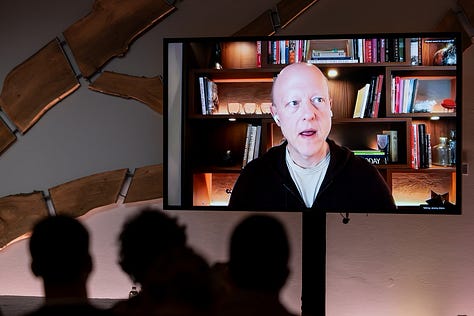March 2025: A Very Stable Conference Season 1: Recap
About a month ago 300 folks converged on San Francisco for (Season 1 of) A Very Stable Conference. We brought the conference together initially to create a space where the people building stablecoin infrastructure could meet with the enterprise payments, finance and treasury professionals who will eventually use stablecoins at work.
In the weeks and months around the conference we got to meet several leaders & founders building and using stablecoins at work. This recap is an attempt to synthesize some observations and learnings. At a high level some key takeaways from the talks are below:
A majority of stablecoin demand is from overseas
Globally, demand for USD dramatically outstrips supply. Given that, it’s not surprising that 80% of Bridge’s demand comes from overseas. It’s also not surprising that there aren’t many examples of mainstream F500 brands utilizing stablecoins in production today.
But overall, the demand for stablecoins roughly reflects outsize demand for dollars (both from consumers and businesses outside the US, and from digital asset users as a settlement currency).
Regulatory clarity is coming
The text for Governor Waller’s talk is here: https://www.federalreserve.gov/newsevents/speech/waller20250212a.htm
Two points stuck jump out. First, regulatory clarity is coming:
“The stablecoin market would benefit from a U.S. regulatory and supervisory framework that addresses stablecoin risks directly, fully, and narrowly.”
In addition to the signaling of a Governor of the Federal Reserve making embargoed remarks at a stablecoin conference, it’s super encouraging to see that policy makers are thinking about a regulatory regime specific to stablecoins, that addresses stablecoin specific risks (as opposed to layering the regulatory regime for banks onto the stablecoin market).
Second, regulatory fragmentation might also be coming:
“Fragmentation in regulation also has the potential to hold stablecoins back from reaching their full potential. As I already discussed, the stablecoin market does not have a clear regulatory framework in the United States. While there have been efforts to develop some international standards, the emergence of different global stablecoin regulatory regimes creates the potential for conflicting regulation domestically and internationally.7”
What this ends up meaning operationally for different stablecoin issuers in different geos still waits to be seen, and curious what the enforcement mechanisms will be. For instance, how does a stablecoin issuer comply with different reserve requirements in different gets? In general, the pragmatic approach Governor Waller outlined is super encouraging for what’s coming down the pike regulatorily.
There’s real enterprise interest in stablecoins, but not much real enterprise adoption (yet)
Several speakers/panelists called out that lots of enterprises and institutions were exploring how to utilize stablecoins. Given the obvious advantages there are 2 big hurdles left to cross:
Regulatory clarity: unsurprisingly, the largest brands in the world, have the most to lose. Regulatory clarity on how to utilize stables, what criteria to use when selecting, and what use cases are sanctioned. In the time since the conference, the evolution of the GENIUS Act, combined with banking regulators like the OCC clarifying positions around crypto, and the various summits around crypto indicate that some regulatory clarity is on the way.
Liquidity: even today, lots of stable to fiat trades happen in group chats over WhatsApp and signal, and moving large sums require working the trade. Lots of folks have built bots to automatically respond and handle incoming messages so they can get liquidity. This is the definition of an OTC Desk (and lots needs to happen for this to scale).
There will (likely) be many stablecoins
Governor Waller called out competition and low barriers to entry as key attributes for developing a vibrant stablecoin ecosystem. At least a half dozen speakers and panelists on stage either directly issue stables or have in house capacity to issue stables; m0, USBC (with deposit tokens) Brale, Bridge, BVNK, Circle & Paxos). These issuers represent everything from startups to scale and every thing in between, and new stablecoin issuers (and stablecoins) emerge every day.
You can buy a Ferrari with USDC
BVNKs Ferrari use case & Stripe buying Bridge both clearly indicate stablecoin acceptance at the point of sale is coming to retail payments. What’s not yet clear is how quickly or slowly retail adoption will follow. But merchants and acquirers are showing increased interest in utilizing stablecoins in production.
Stablecoins are coming for (or to?) banks
It’s clear banks have a role to play in the stablecoin future. It’s less clear what that role will be. Banks like Lead and others have already provided support for stablecoin issuers (and access to fiat rails) for years. Efforts like USBC will enable banks to deploy deposit tokens (ie a stablecoin with all the attributes of a deposit, including being fractional, having FDIC protection, Reg E protection etc).
Governor Waller called out that it’s fairly logical for banks to be able to issue stablecoins (in addition to issuing deposits). I’d be surprised if whatever ongoing legislative/regulatory/policy approach did not allow for banks to participate in stablecoin issuance. Even the GENIUS ACT alludes to this:
One last, broad takeaway (not specific to the conference). Americans (and westerners in general) who work in payments have a unique blindspot around stablecoins (and by extension around blockchains in general - more on this later). From what I can tell there are 2 current driving forces for the current phase of stablecoin adoption: 1) digital assets needed a settlement currency and 2) non-US consumers and SMBs needing access to dollars for payments, for savings, for currency stability etc. The corporate treasury and enterprise use cases definitely lag these two in adoption.
The leaders in payments in the US, literally do not spend any meaningful time on either of those 2 problems. There is probably no living American who works in payments that has experienced an unstable/volatile/hyperinflated USD. In a lot of cases these folks aren’t even skeptical of stablecoins, they’re almost indifferent. For the most part stablecoins don’t (yet) solve problems in their day to day, and at least until recently, have not had enough scale in the contexts that move the needle for them. So they don’t pay attention to them. This is starting to change, but is my current best explanation for why enterprise adoption has lagged.
All in all - the gathering was a roaring success. Thankful to everyone who came, and looking forward to Season 2.







Thanks to Kerry Kellogg for reading this in draft form.


